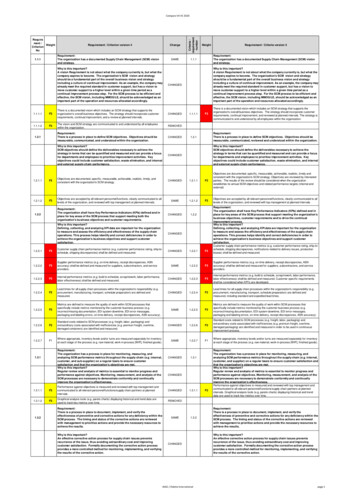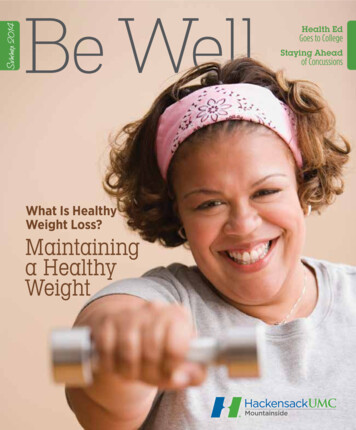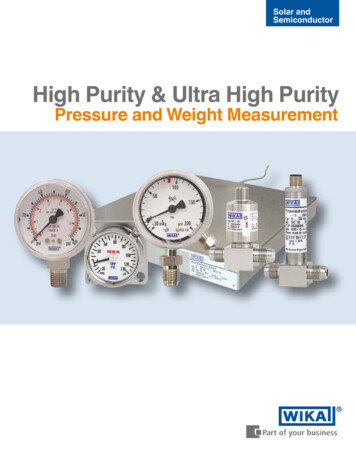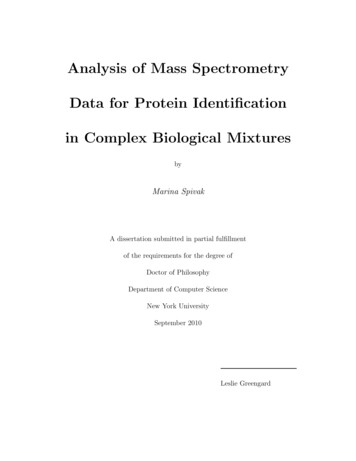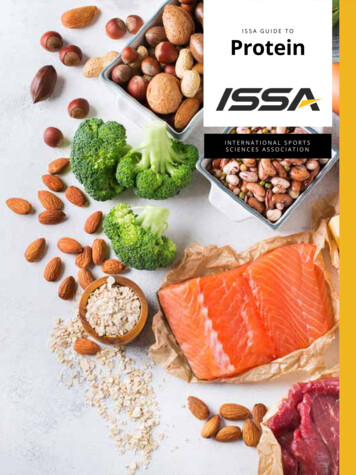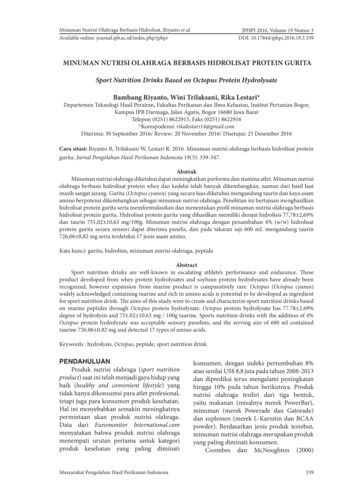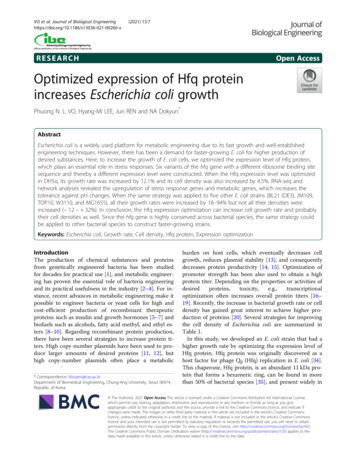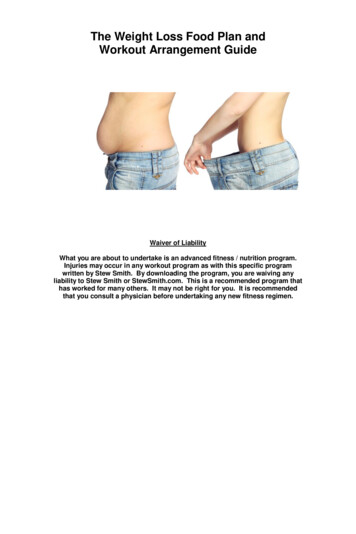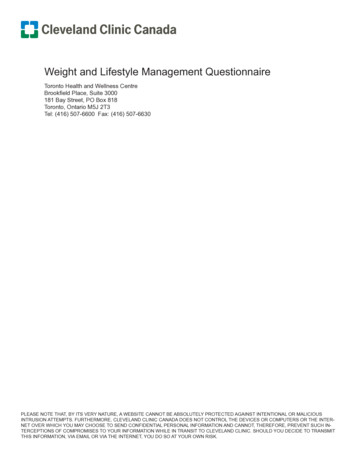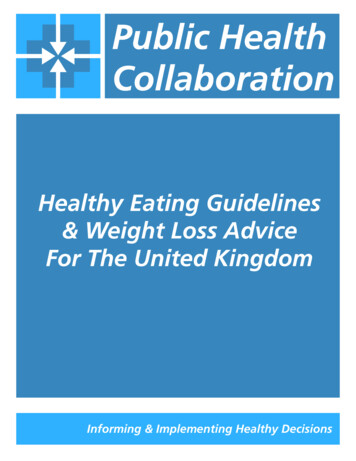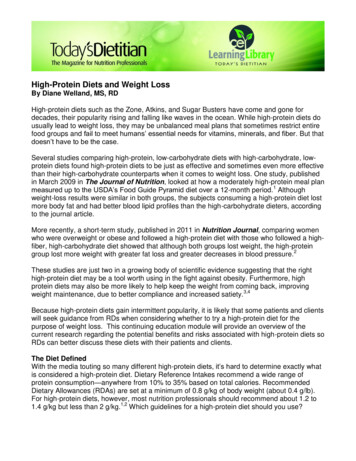
Transcription
High-Protein Diets and Weight LossBy Diane Welland, MS, RDHigh-protein diets such as the Zone, Atkins, and Sugar Busters have come and gone fordecades, their popularity rising and falling like waves in the ocean. While high-protein diets dousually lead to weight loss, they may be unbalanced meal plans that sometimes restrict entirefood groups and fail to meet humans‟ essential needs for vitamins, minerals, and fiber. But thatdoesn‟t have to be the case.Several studies comparing high-protein, low-carbohydrate diets with high-carbohydrate, lowprotein diets found high-protein diets to be just as effective and sometimes even more effectivethan their high-carbohydrate counterparts when it comes to weight loss. One study, publishedin March 2009 in The Journal of Nutrition, looked at how a moderately high-protein meal planmeasured up to the USDA‟s Food Guide Pyramid diet over a 12-month period.1 Althoughweight-loss results were similar in both groups, the subjects consuming a high-protein diet lostmore body fat and had better blood lipid profiles than the high-carbohydrate dieters, accordingto the journal article.More recently, a short-term study, published in 2011 in Nutrition Journal, comparing womenwho were overweight or obese and followed a high-protein diet with those who followed a highfiber, high-carbohydrate diet showed that although both groups lost weight, the high-proteingroup lost more weight with greater fat loss and greater decreases in blood pressure.2These studies are just two in a growing body of scientific evidence suggesting that the righthigh-protein diet may be a tool worth using in the fight against obesity. Furthermore, highprotein diets may also be more likely to help keep the weight from coming back, improvingweight maintenance, due to better compliance and increased satiety. 3,4Because high-protein diets gain intermittent popularity, it is likely that some patients and clientswill seek guidance from RDs when considering whether to try a high-protein diet for thepurpose of weight loss. This continuing education module will provide an overview of thecurrent research regarding the potential benefits and risks associated with high-protein diets soRDs can better discuss these diets with their patients and clients.The Diet DefinedWith the media touting so many different high-protein diets, it‟s hard to determine exactly whatis considered a high-protein diet. Dietary Reference Intakes recommend a wide range ofprotein consumption—anywhere from 10% to 35% based on total calories. RecommendedDietary Allowances (RDAs) are set at a minimum of 0.8 g/kg of body weight (about 0.4 g/lb).For high-protein diets, however, most nutrition professionals should recommend about 1.2 to1.4 g/kg but less than 2 g/kg.1,2 Which guidelines for a high-protein diet should you use?
“Whenever you‟re talking about weight loss, you should always base protein needs on bodyweight, not percentage of calories,” says Donald Layman, PhD, professor emeritus of nutritionfrom the University of Illinois. “Percentage of calories is very misleading. Drop your caloriesand protein can easily dip below minimum levels. Keep the amount of protein the same and itcan be considered high protein on one diet and low protein on another, yet it‟s still the sameamount of protein.”Layman, who categorizes diets he uses in research and with patients as moderate in protein,aims for intakes between 120 and 130 g/day (about 1.4 to 1.5 g/kg of body weight), which isnearly double the RDA. “The average American woman eats about 70 g of protein a day and aman around 90 g per day, so most people would consider this a high-protein diet,” Laymansays.The rest of a high-protein diet is balanced between carbohydrates and fats. “Most traditionalhigh-protein diets run about 40% to 45% carbohydrates, 25% to 30% protein, and no morethan 30% fat, which turns out to be a pretty achievable diet,” says Roberta Anding, MS, RD,LD, CDE, CSSD, a spokesperson for the Academy of Nutrition and Dietetics (the Academy)and director of sports nutrition at Baylor College of Medicine in Houston. She says some highprotein diets even contain as much as 35% protein.In addition to protein, Layman‟s laboratory diets usually include five servings of vegetables,two to three servings of fruit, and three servings of complex carbohydrates. Layman‟slaboratory carbohydrate guideline is less than 40% of calories, with no more than 40 g atbreakfast and lunch, and his laboratory fat guideline is 30% of calories.But why do we need so much protein? In his commentary on adults‟ protein needs, publishedin March 2009 in Nutrition & Metabolism, Layman cites research showing that increasedprotein intake can benefit patients with osteoporosis, type 2 diabetes, metabolic syndrome,heart disease, and sarcopenia in addition to obesity.5 Furthermore, as we age, our ability toefficiently utilize protein decreases.“If you asked the average consumer who needs more protein, a 16-year-old or a 65-year-old,most people would say the 16-year-old,” says Layman. “In reality, it‟s the 65-year-old. Theylikely need fewer calories, but they need more high-quality, nutrient-dense protein—along withexercise and, specifically, resistance training—to prevent muscle wasting.”And while conventional weight-loss teachings generally reduce calories across allmacronutrients (protein, fat, and carbohydrates), Layman says weight loss itself raises proteinneeds. “Losing weight is a stress on the body,” he says, “and any stress will increase proteinneeds.”Protein PowerWhat gives protein the edge over carbohydrates when it comes to weight loss? In a word:satiety. Protein promotes greater satiety than either carbohydrates or fat, making people feel
fuller and more satisfied for a longer period of time. As a result, they can better control theirappetite and eat less.6,7“I deal with mainly morbidly obese clients, and you just can‟t get that satiety on a highcarbohydrate diet. They‟re always hungry,” says Anding. “On a high-protein diet, clients feelless hungry, so they‟ll stay with it.”Some studies have shown that subjects who replace carbohydrate with protein eat roughly 200to 400 fewer kcal per day than high-carbohydrate dieters and find it easier to self-regulate theirintake.1,8High-protein dieters also reported a reduced desire to eat late at night and a reducedpreoccupation with thoughts of food compared with their counterparts consuming moderateamounts of protein during a longitudinal 12-week study on overweight and obese men.9 Theseresults support Anding‟s observations and suggest high-protein diets could lead to less latenight snacking and overeating in the evening—two of the main factors that lead people toabandon a weight-loss plan.Although many dietitians recommend eating six small meals per day to keep hunger at bay,the research doesn‟t bear out the necessity of such frequent eating. The 12-week study, whichalso looked at eating frequency, found no difference in appetite and satiety when the subjectshad three eating occasions per day vs. six, no matter the protein content of the diet.9 Theseresults have been observed in several other studies and are discussed as part of the 12-weekstudy.9 In fact, researchers noted a slight but not significant decrease in late-night fullness forsubjects on the high-protein diet who ate six times per day and said this eating plan may beharder to follow, particularly for people unaccustomed to eating smaller, frequent mealsthroughout the day.More Than Just SatietyAnother way protein benefits weight control is via thermogenesis, or the amount of energyneeded to digest, absorb, and metabolize nutrients. Because protein has a higher rate ofthermogenesis than both carbohydrate and fat (three times higher than carbohydrate and asmuch as 10 times higher than fat), the human body burns more calories in the process ofdigesting protein than it does in the process of digesting carbohydrate or fat.5-7,9,10But the biggest impact on metabolism and energy expenditure by far involves protein‟s role inboth muscle building and maintenance. Commenting on his research, Layman explains, “Youneed at least 30 g of protein in one meal to stimulate muscle building. That‟s the minimum. Onthe other hand, anything over 50 g and you‟re maxed out. Protein then just gets oxidized, andthere‟s no additional muscle benefit. Just to give you an idea of how much that is, sirloin steakcontains about 8 g of protein per ounce, so 6 oz would be all you would need per meal.”5Research shows that after three or four days on a high-protein diet, protein turnover, whichincludes both protein buildup and breakdown, speeds up as a result of the body adjusting to ahigher protein intake. This, in turn, increases energy expenditure, raising resting metabolic rate
as well, even with a lower energy intake. Combined with exercise, higher protein intakes canproduce an even greater rise in resting metabolic rate.10Unfortunately, consuming 30 to 50 g of protein at every meal can be a problem, particularly foradult Americans, who tend to eat almost all their protein in a single meal: dinner. NationalHealth and Nutrition Examination Survey data show Americans consume more than 65% oftheir daily protein intake in a single large meal (dinner), leaving less than 35% to be distributedthroughout other earlier meals.11“Since positive protein balance only lasts about three hours after ingestion, it‟s important to eatenough protein throughout the day,” says Layman, “and that can be pretty challenging for mostpeople.” Thanks to our penchant for high-carbohydrate foods such as pasta, it‟s not surprisingthat our lunches are often short on protein. Breakfast, however, contains the least amount ofprotein of any meal. According to Layman, most Americans average only 10 g of protein for themorning meal. This is particularly problematic because lean tissues are most catabolic whilewe sleep.5,11 Failing to consume enough protein during breakfast will keep you in a catabolicstate and increase protein breakdown until you eat a high-protein meal (more than 30 g).Since both breakfast and lunch typically contain less than 15 g of protein per meal, theaverage person may go up to 20 hours between eating high-protein meals and reversing thiscatabolic state. During a catabolic state, muscle protein synthesis decreases and muscleprotein breakdown rises. At the same time, overall protein turnover (building up and breakingdown of protein) slows, resulting in less protein being synthesized. Thus, skipping breakfast oreating a low-protein breakfast will promote protein breakdown rather than fat loss. 5,11Furthermore, a good-quality high-protein breakfast is even more important as we age. Whileeating your daily protein in a single meal does not adversely affect growth in children andyoung adults, eating protein throughout the day does become more important for older adults.This is because muscle protein synthesis is regulated by dietary energy and insulin in youngpeople, but in older adults, muscle protein synthesis is regulated by the amino acid leucine.Consequently, protein intake promotes protein synthesis rather than energy intake. For olderadults, this means eating high-quality protein throughout the day can protect lean tissuesduring weight loss and prevent age-related sarcopenia and osteoporosis.5,11In light of these findings, breakfast becomes the most important high-protein meal of the day.In addition, breakfast eaters are more likely to have a better-quality diet and less likely toovereat, particularly at night. Skipping breakfast, on the other hand, leads to an increasedappetite and hunger and poorer food choices later on in the day. 12Studies show regularly eating the right kind of breakfast not only helps people lose weight, italso helps them keep the weight off for good. A high-protein breakfast will reduce proteinbreakdown and keep hunger at bay, helping people feel full longer.To help clients meet their protein needs during breakfast, dietitians should suggest creativeways to incorporate high-protein items such as chicken, fish, meat, eggs, cheese, Greekyogurt, milk, tofu, or beans into breakfast foods.
Building lean muscle mass isn‟t the only benefit of high-protein diets; this type of eating alsopreserves lean body mass during weight loss.13 Commenting on his research, Layman notesthat “during starvation, we break down about 50% lean tissue and 50% fat. If you lose weightusing a high-carbohydrate diet similar to the Food Guide Pyramid, you‟ll be breaking downabout 35% lean tissue and 65% fat. Now go on a high-protein diet, and our research showslean tissue breakdown drops to 20%, while fat breakdown increases to 80%. Add exercise tothe mix, and protein breakdown drops even lower—below 10%.”5,13Anding, who also counsels National Football League (NFL) players, has seen similar results.“We‟ve done a pilot study looking at high-protein diets—1.8 to 2 g of protein per kilogram ofbody weight—weight loss, and body composition in three groups: walkers, walkers with Pilatesclasses, and walkers with Pilates classes and weight training,” says Anding. “Only the weighttraining group hung on to their lean muscle.” In fact, high-intensity weight training “using theheaviest weights with meticulous form” along with a high-protein diet was the only type ofregime that resulted in no loss of lean muscle tissue and optimum weight loss. “We call this our„retired‟ NFL diet,” notes Anding.Other new research points to an inverse relationship between protein intake and abdominalobesity, which is the worst type of obesity because of its association with a statistically higherincidence of chronic disease. To date, only a few studies have been conducted. 14 Preliminaryresearch published in 2012 in Nutrition & Metabolism found that eating higher amounts ofhigh-quality protein (milk, eggs, and beef) was associated with a lower percentage of centralabdominal fat. This inverse relationship was not seen for
fiber, high-carbohydrate diet showed that although both groups lost weight, the high-protein group lost more weight with greater fat loss and greater decreases in blood pressure.2 These studies are just two in a growing body of scientific evidence suggesting that the right high-protein diet may be a tool worth using in the fight against obesity. Furthermore, highFile Size: 379KBPage Count: 12
